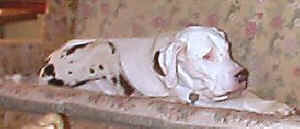|
Anterior Cruciate Ligament
Dogs knees are similar to humans. Knees have five
ligaments, two menisci, a knee cap, and joint cartilage. The ligament
most commonly affected in the dog knees are the cranial cruciate
ligament, the same ligament most commonly damaged in humans. Dogs
usually tear this ligament when playing.
The cranial cruciate ligament is a large
ligament located within the knee joint. It is not actually a single
structure, but is in fact made up of a bundle of individual fibers
tightly bound together to form the ligament. Most of the time when the
ligament is injured, it is completely torn in half. Sometimes, though,
only a portion of the ligament will tear. Even though only a portion of the
ligament may be torn, the whole ligament is damaged.
When a cranial cruciate ligament is torn, it causes
sudden extreme pain and results in the dog holding its leg up. It also
causes an instability in the knee joint. The dog may put the leg down
and start using it within a day or so, but will continue to limp for
several weeks. Normally, at the end of several weeks, the initial pain
subsides and the dog is willing to use its leg more, but the
joint remains unstable. Every time the dog puts weight on the leg, the
tibia (shin bone) slides forward in relationship to the femur (thigh
bone). This abnormal motion causes wear and tear on the joint cartilage,
causing pain and leading to arthritis. This motion can also put
excessive stress on the menisci (C shaped pieces of cartilage within the
knee joint), causing tearing and or damage.
Surgery is the only corrective measure for cranial
cruciate ligament injuries. Many surgical procedures have been tried on
people and dogs but most orthopaedic
surgeons agree that the procedures are not as successful as they would
like. Knees that suffer this injury are never completely normal even
after surgery is performed. Surgery does stabilize the knee, allowing
it to regain normal motion and reducing the formation of arthritis.
Surgery is the treatment of choice for this injury. If
surgery is not performed, arthritis will occur and the
lameness will worsen with time.
There are many different ways to stabilize a knee
with a cruciate ligament injury. The procedure most often used involves placing
either heavy gauge suture material or orthopaedic wire from the back of
the femur, across the joint, and to the front of the tibia. This will
tighten up the joint and stabilize it. Over time, scar tissue will lay
down around the suture or wire to form a structure which mimics the
function of the normal cranial cruciate ligament. The majority of dogs
will regain normal or near normal use of their leg after the
surgery and rehabilitation. Limited activity is necessary after the surgery for a period of
at least six weeks so
that the dog does not over stress the repair before the scar tissue
has formed. Total rehabilitation time, can be several
months.
For more information and diagrams please visit these
PetSurgery.com links:
Anterior
Cruciate Ligament Rupture and
Tibial Plateau Leveling Osteotomy.
Here is Harley a beautiful
Dane whose mom wants to tell his story.

All images and text on this site Copyright © 1998-2025 Harlequin Haven Great Dane Rescue, Inc. unless otherwise credited. Use of any image or text without written permission is expressly forbidden. All rights reserved.
|

